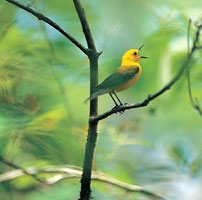Wildlife - Species
Prothonotary Warbler (Protonotaria citrea)
Description
The prothonotary warbler takes its name from "protonatary," an official of the Catholic church who wears a bright yellow hood. As its name implies, this beautiful bird is very brightly colored. The male prothonotary has a lemon yellow body with an olive back and bluish or slate gray wings. Its tail is black with white areas, and its bill is also black. As in many species of birds, females resemble their counterparts but their colors are duller. Female prothonotary warblers also differ from male warblers in that the top of the head and the back of the neck are olive green.
Preferred Habitat and Biology
This species breeds in southeastern states north to Minnesota, Michigan, and New York and spends its winters in the tropics. Prothonotary warblers are characteristic birds of southern swamplands. They build their nests in tree cavities that are in close proximity to water. Most warbler species construct their nests in dense bushes. However, the prothonotary warbler is only one of two species of wood warblers that uses tree cavities for nesting (the other one being Lucy's warbler, Vermivora luciae). Nesting season extends from late April to early May. Nests are placed within natural cavities of stubs, trees, or wooden structures. Clutches usually contain 4-7 eggs, one or two broods are raised, and incubation requires 10-14 days. Southward migration from South Carolina occurs about mid-July.Species Significance
Prothonotary Warblers are not officially recognized as threatened or endangered, but all species of the Forested Wetlands Birds Guild (grouped together because they either nest or winter primarily in forested wetlands in South Carolina) are either experiencing declines or declines are suspected.
References
Blem, C. R., and L. B. Blem. 1992. Prothonotary warblers nesting in nest boxes: clutch size and timing in Virginia. The Raven 63(1): 15-20.
Bull, J. L. and J. Farrand, Jr. 1995. National Audubon Society Field Guide to North American Birds. Eastern Region. The Audubon Society field guide series. Alfred A. Knopf Inc., New York, NY.
Sprunt, A., Jr. and E. B. Chamberlain. 1970. South Carolina bird life. University of South Carolina Press, Columbia, SC.

